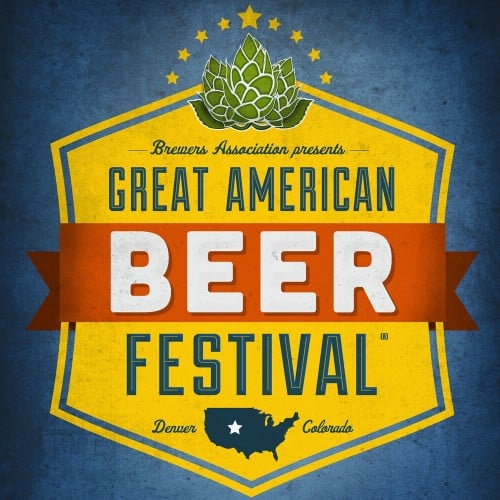
125 members of the media along with a score of craftbrewers and homebrewing elite met at noon Friday, inside Denver?s Grand Hyatt Pinnacle Club Peak Ballroom on the 38th floor for a working?media luncheon consisting of a five-course pairing luncheon and briefing. The theme was ?homebrewing and its connection to the craft brewing community?, and the idea was to ?highlight a few commercial beers that were inspired by their homebrewing roots.?
Are you a homebrewer who has ever considered going pro? This luncheon was all about people like you!
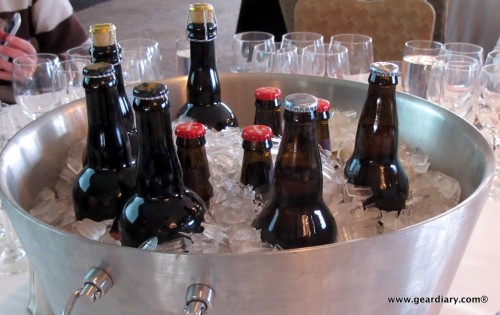
It?s easy to forget that just about every craft beer you can buy in the specialty beer case at your grocery store was created by brewer who likely started as a homebrewer. Just as so many famous tech companies were founded in their creator?s garages, so too were the origins of many craft beer companies.
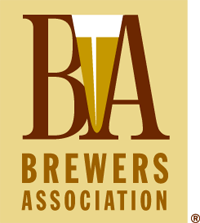
We were welcomed to the luncheon by Julia Herz, Craft Beer Program Director, of the?Brewers Association.
Julia is an award winning homebrewer, Certified CiceroneTM, BJCP beer judge and all around beer lover. Her focus?at?the association is on resources and education on craft beer, general statistics on the craft beer industry, beer styles and trends and beer and food pairing.
Julie explained that we would be enjoying a five course lunch paired with the beers on our menus. Most of these bottled or canned beers were in the large ice bucket (shown above) in the centers of our tables.
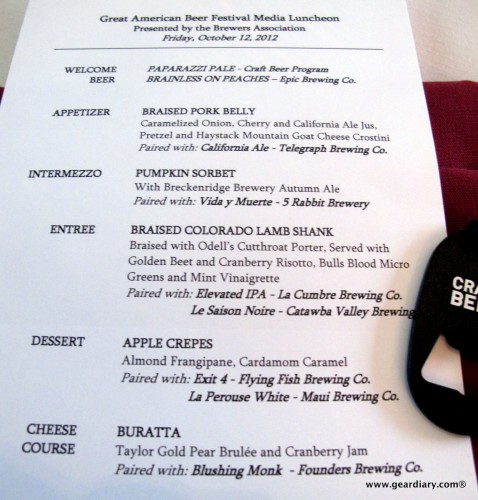
Our first speaker was Kim Jordan, President,?New Belgium Brewing Company, in?Fort Collins, Colorado; she also serves on the Brewers Association Board of Directors.
?
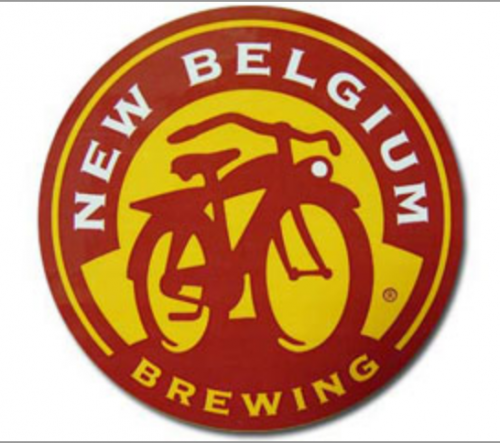
The other side of the New Belgium story isn?t as romantic as bicycling through Europe, but it gives testament to our dedication and hard work. And it goes like this: Jeff,?an electrical engineer by day and tinkerer by nature, builds a homebrewing kit in his basement out of repurposed dairy equipment. His Belgian inspired brews garnered?enough praise from friends and neighbors that Jeff and Kim take their basement brewery commercial in 1991.?Kim, social worker by day and mother to two always, began the marketing process by knocking on their neighbor?s door. Anne Fitch was that neighbor and her watercolors are the artwork we continue to use on our labels today. With labeled bottles and local encouragement, the first Belgian-style beers brewed in the United States were officially for sale.?Bringing Peter Bouckaert, a Belgian Brewmaster working at Rodenbach, on in 1996 helped influence our love of sour beers. Moving forward, Peter would take the brewing reins as Jeff began pursuing other interests. In 2009, Jeff moved on completely and we have continued to flourish with Kim, Peter, and a team of dedicated employee-owners at the helm.
One of the first things that Kim mentioned was that there are more than 1500 craft breweries in the United States, and there are nearly a million?homebrewers. She said that whether they know it or not, most Americans live within 10 miles of some kind of brewpub or brewery. I?m guessing that?s a number that mainly applies to people in urban settings, as our closest brewpub is about 40 miles away. (sad face)
She also gave a bit of back story, as to how at one point there had been a question as to whether the Brewers Association should just be for trade professionals, or whether it should include homebrewers as well. In the end, they realized that keeping trade professionals and homebrewing aficionados?together would only improve the energy of the entire organization.
Kevin Crompton, from?Epic Brewing Company, located in Salt Lake City, Utah, was our next speaker.

Admittedly, beer geeks, foodies and epic adventure junkies, the three [David Cole, Peter Erickson, and Kevin Crompton]?share a passion for making and drinking fine ales and lagers. The EPIC team has a strong belief in doing everything ?all out.?
Epic Brewing?s Brainless on Peaches?was the 2011 Great American Beer Festival silver winner for a Fruit Beer. I had to pass on tasting this ?welcome beer?, because I am allergic to peaches; it did have an amazing aroma, though.
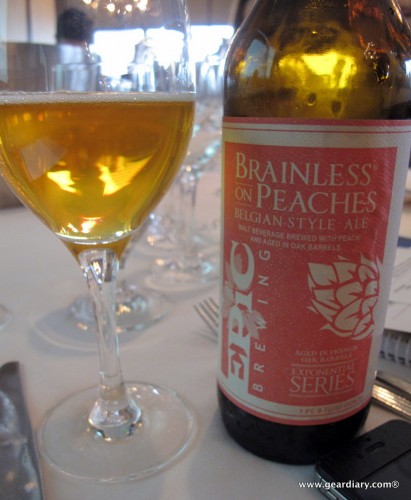
Kevin mentioned that Epic is the ?first brewery in Utah since prohibition to?exclusively produce beers containing greater than 3.2% alcohol.? As a result, it keeps them from having beer on draft in Utah; 100% of their beer sold in the state of Utah have to be sold in bottles (draft beer sold in Utah can?t be more than 3.2%).
Epic Brewing Company opened its doors in July, 2010, and they have grown extremely fast. They are currently at 600 barrels?fermentation capacity, and they are casting out 25 ? 35 brews a week, which is ?kind of crazy on a 10 barrel system.?
Brainless on Peaches is a barrel-aged beer; ?they take an existing brand, called Brainless Belgium (a Belgium gold strong ale) ?and they add it to chardonnay casks that have been freshly drained within 30 days, and then they add a pound of fruit puree per gallon into the casks, so ?62 gallons is 62 pounds of fruit puree? per cask!
They went with peach puree over fruit extract for the more juicy flavor profile; they wanted a ?nice fruity aroma and an aftertaste of fruit?, but they didn?t want something ?like a Jolly Rancher?. The beer is very wine-like, because it is aged in wine casks. The Belgium beer they use as a base weighs in at 8.5% alcohol, and after the aging process and the extra fermentation in the wine casks, it weighs in somewhere between 10.5 ? 11% alcohol, and it is extremely dry.
?It?s a very delicious beer that is very bright.?
Kevin started as a homebrewer in 1991; about a year later he applied for a job to manage a homebrewing?store. He worked there for about a year and a half, before realizing that he was ?on to something cool [with his homebrewing], and he wanted to make a career of this.?
He applied at various microbreweries, giving them samples and hoping they would be impressed enough that they would give him a job, ?but it didn?t work out that way.? He finally got a job as a tank washer in 1994; ?I probably washed about 50,000 kegs until I was promoted in the cellars.??He said that in the brewing industry, ?if you work hard and you have focus, there is nothing you can?t accomplish?
Kevin is now the head brewer at Epic Brewing Company, and they have grown to the point that they are trying to expand and open a second location in Colorado, which he inadvertently?announced right then and there. Ooops.
Now started our luncheon with pairings; while we enjoyed the course and its beer accompaniment, a speaker from each brewery would come and tell us a little bit about themselves or the beer we were enjoying ?
First up was Scott Baer, Director of Brewery Operations for?Telegraph Brewing Company, from?Santa Barbara, California. He said that his title is a ?fun and grandiose? designation that he has earned as the most senior of three employees at Telegraph Brewing Company. Telegraph was founded just over 7 years ago. They specialize in Belgium inspired ales.
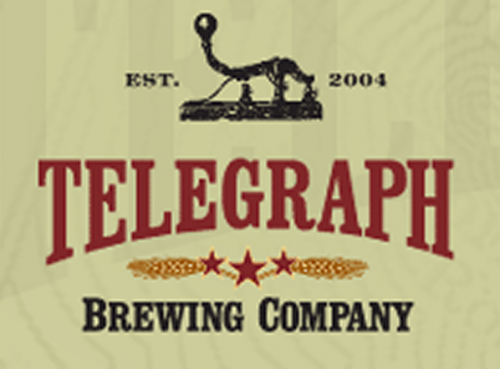
Each of Telegraph?s brews is carefully crafted in small batches in our traditional copper-clad?brewery. We respectfully employ brewing techniques proven over the centuries while eschewing modern shortcuts that might make our lives easier but inevitably lead to less distinctive beers. However, just like you, Telegraph Brewing Co.?isn?t?afraid of trying something new. That?s something you?ll discover on taking your first sip of our beer. We are proud to be a small part of California?s rich brewing heritage and we hope that with each pint you can taste the perfect blend of the past and the future.
As our braised pork belly appetizers were delivered to our tables, we passed around and poured freshly opened bottles of Telegraph?s California Ale.
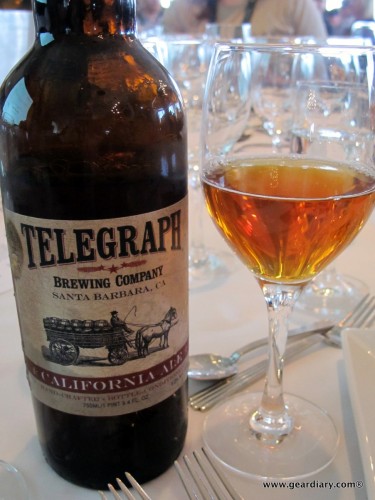
Scott developed an interest in beer while in college, and he tried his hands at brewing his own. He was educated as an engineer, so his homebrewing approach was ?systematic and thorough. [He] did a lot of research before actually brewing his first batch,? but he quickly developed a passion for it. Four and a half years ago, he walked into Telegraph Brewery with his resume in hand responding to an opening they had. They took a chance on him, and he has been there ever since.
He said that ?craft brewing, much like homebrewing, is such a fulfilling combination of hard work, ingenuity, creativity?and productivity.? California Ale was born as a homebrew,?conceived of by the owner and original brewer at Telegraph, Brian Thompson. It has an emphasis on West Coast hops (like centennials and cascades), combining that with a ?traditional Belgium brewers emphasis on unique beers, creative, and interesting yeast characteristics.?
California Ale is a hybrid-style beer that they sometimes have difficulty labeling, but they prefer to refer to it as a ?Belgium inspired amber ale?, and in fact it won its gold medal in the French ? Belgium Style Ale category at last year?s GABF.
California Ale is a deep copper color, with effervescent carbonation that they achieve through bottle conditioning. ?The aroma is earthy and subtly hoppy?with the promise of caramel and hints of citrus, and the taste follows through on that promise. The malt character is robust, and the hops are in balance, and the finish has a lot of fruity esters.?
Scott said that Telegraph feels that California Ale?pairs very well with savory dishes, and I would have to agree, based on tasting it with the braised pork belly we sampled.
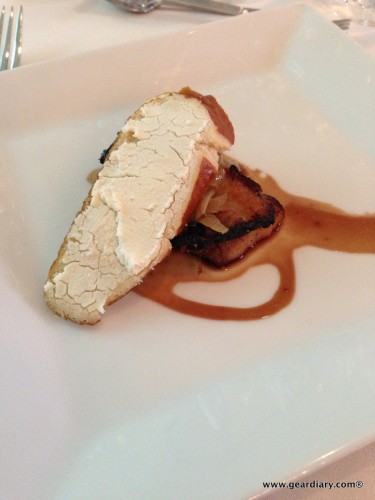
Randy Mosher, one of the three partners at?5 Rabbit Cerveceria?in Bedford Park, Illinois, was our next speaker. He asked us all to go back about 140 years, back to the middle of the last century, and think about the attitude of the day, especially in the US; it was about work, about commerce, and it was about industry. He said, ?we started to develop a culture of national brands, of things like soup, and bread, and cheese, and things like that. And that went on for a number of years, and it turns out that there was this notion that we, humanity, were headed for inexorable progress; that this was the was the ultimate idea of modernism that dominated the 20th century, and that technology would get us there.?
?It turns out that this technology was really good for things like making airplanes, but not so great for bread, and cheese, and beer. You know, we use that phrase ?the greatest thing since sliced bread?, which [defined] what this era meant, but it turns out that the things you have to do to make bread sliceable,?it?s like what Garrett Oliver calls a ?food facsimile?. It?s not quite food. So what we are seeing today, is this desire to return to products that are more human than stale. And these extremely intimate products are the things that we put in our mouth ? food, and drink, and bread, and coffee, and cheese, and all those things ? we don?t want giant corporations dominating that. We don?t want marketing committees and advertising; people really want to know the people who produce their products, they are looking for products with meaning, with soul, and with a purpose. And that is the underlying purpose that drives all this [the craft brew movement].?
He went on to say that in the 70s, there wasn?t any good beer in the US; ?there was nothing left! It was this desert, this barren vacuum in terms of beer, and in the great American fashion, we just started brewing it in our basements.? Randy finds it exciting that even today, ?in this beer paradise that we are living in, with in Portland and Seattle, there are still people homebrewing; they want to get their hands dirty and do it.?
Randy started his career as a graphic designer; he worked in advertising, and he fell in love with beer in the 1980s, and he started homebrewing. He started piling up notes and wrote a book on homebrewing. At a book signing in the Map Room bar in Chicago, he got into a discussion with two other men of Latin American descent about their project, which was to ?reinvent Latin American beer for the 21st century.? He found that really fascinating, and ?one thing led to another, and eventually the others decided he was useful enough to the organization that they took him in as a partner. ? 
The name 5 Rabbit embodies the mysticism, color, and playfulness of this rich Latin heritage. Based on Aztec mythology, it provides deep roots?to?our vision of Latin America that inspires our beers and everything else we do. We are 5 Rabbit and we have come to liberate the true spirit of beer.
5 Rabbits has been in business since May 2011; they have been contract brewing, making about 2500 barrels a year right now. They also have a 30 barrel, four vessel DME brewhouse that is going to be delivered on Monday to a 2500 square foot facility in Bedford Park, on Chicago?s south side. They are really excited to get their hands on their own beers, and get out of contract brewing to make their own beer.
So to digress for a moment, 5 Rabbits is trying to ?reinvent Latin American beers, and that doesn?t mean copying current Mexican beers. In [their] mind, that doesn?t really have anything to do with anything that is uniquely Mexican. It?s more like American Lagers, which started out as German beers, and sort of developed a little bit.? They wanted to do something that was distinctly Latin American, so they looked at the wildly varied flavors of Latin American cuisine and they drew inspiration from that.
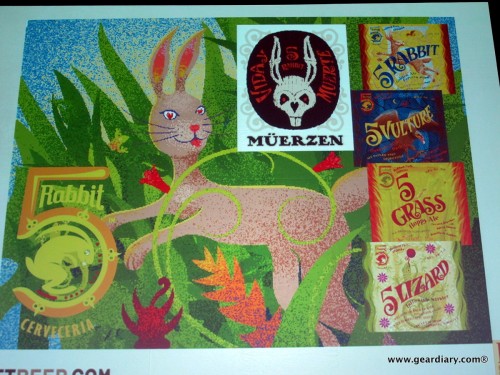
Our intermezzo, a spoon of pumpkin sorbet, was paired with?5 Rabbit?s Vida y Muerte, which they jokingly call their M?erzen. Because it is their fall beer, they decided to drink as with the day of the dead, so their rabbit has bone ears. It starts out as an Octoberfest grist, and then they hop it up a little bit and ferment it as an ale. The beer has Mexican?cinnamon,?some allspice and other flavors. ?They also use an Argentine milk caramel, called dulce de leche, which gives it a really nice caramel flavor.
According to Randy, ?the overall effect of the beer is a bit like graham crackers, and that?s a flavor everybody loves.?
Our next speaker was introduced as a??geologist turned brewpub maverick? who had worked his way up as a small business owner and one of the founders of?Wyncoop Brewery. It turns out that he is now the current?Colorado Governor, John Hickenlooper.
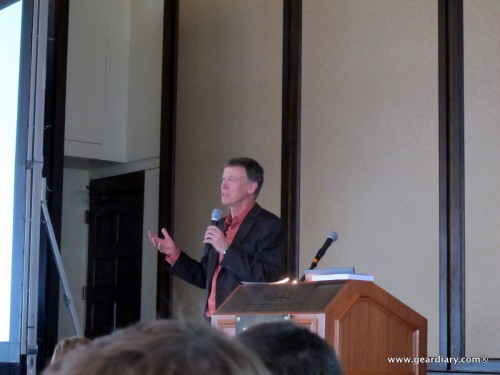
Governor Hickenlooper started with, ?what can I say? You guys are my peeps in every sense.? ?He then said that he brewed his first batch of homebrew in Washington County, Maine, in the summer of 1971; he said that beer was ?very inexpensive, but not exactly digestible. They opened the Wyncoop in 1988, and he said that now, 4.6% of the beer consumed in Colorado is craft beer; 4400 jobs are created in that craft process. He said we need more artisan craft-based industries like craft beer, with people taking the time to put in for the creation of individual batches, and then other people saying this is worth the extra 50? or 75?.
According to the Governor, the GABF brings $7 million to the local economy, and that it is a beacon to the rest of the world. He said that he hears more and more, that foreigners who visit are talking about craft beer as part of the experience of visiting the United States. He also mentioned that California has almost twice the number of breweries that Colorado has, but they also have seven times the population; so he said that ?just doing simple math, they are five times behind us.?
As they began to bring out our entrees, our table mate Todd Steven?Boera, the head brewer for?Catawba Valley Brewing Company?in Morganton, North Carolina stepped up to the dais to speak. Catabwa Valley Brewing Company was founded in 1999 by the two owners who started out with a homebrewing?Christmas gift, and from that grew into a love of craft beer.
?For a long time, Catabwa Valley focussed on traditional, pretty basic?recipes, doing things from red ales to IPAs with a few specialties set aside ? Coconut Porter and one of the first black IPAs to hit the scene ? but since then we?ve moved into the direction of doing a bunch of Belgian style ales and a lot of barrel aging, and moving into the sour categories of brewing beer. We really try to go out of the box, and it couldn?t have come at a better time, because that seems to be where the public wants to be moving towards in drinking, getting their hands on exciting beers. Todd has been brewing at Catabwa Valley for four years, and before that he started homebrewing?in 2002, ?reading the books of many of the people in this room that gave [him] ideas and gave [him] inspiration.?
He wasn?t sure where the quote originated, but Todd Steven says he often hears that ?there is a homebrewer behind every craft brewing company in the country,? and whether that is true or not, he said that ?it pays a great deal of attention to how appreciated homebrewers?are, and how necessary homebrewers are in the craftbrewing professional arena.?
?
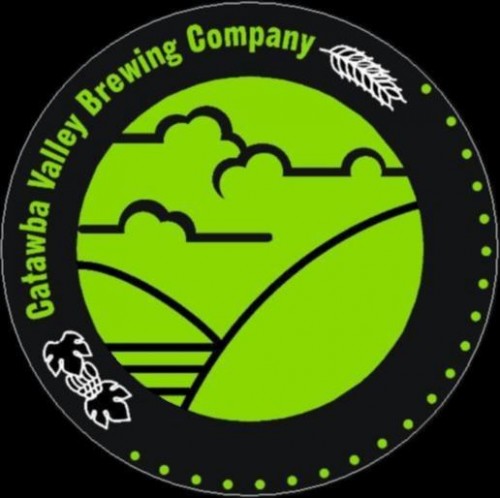
Todd Steven said that he talked his way into the job at Catabwa Brewing Company, ?[he] was traveling around Europe and was in Belgium and in Portugal, and [he] was sending emails to the owner saying, ?I?m coming back ? you have to hire me!?, and that worked! I?m not really sure how that worked!? He started as the assistant brewer, and quickly moved to the head brewer, working on ?really cool beer recipes like the ones y?all have in front of you.?
At Catawba Valley Brewing, micro is the operative word. Scott Pyatt efficiently divides his time between brewing and selling. A phone call to the brewery is almost always?answered by his recorded voice: ?If we?re not here, we?re delivering beer.? You gotta?believe him.?
Catabwa had two beers to serve with our entree; La Saison Noir and Loretta; both were poured in the kitchen and served to us at the table, so I don?t have pictures of their containers.
La Saison Noir is not a typical style of beer, but Todd Steven noted that you will be seeing more and more breweries releasing their interesting interpretations on saisons. ?And again, that?s the homebrewer?side of the craft beer industry trying to push the limits, saying well, saison?meant something thing for a very long time, but we can change it and make it something even more unique.? So La Saison Noir is their ?interpretation of a black saison; it is fermented with a blend of five different Belgian saison?yeasts, so it has a really beautiful phenolic character on the nose. To get the beer to turn a little bit black, they use a dark Belgian candy syrup, ?so you don?t have the cloying nature from using roasted or caramel malts as much.? The beer is 7.8% alcohol, although it doesn?t drink like it; ?it goes down with a really nice chocolatey, dry, tart finish.?
They released it in the summer, which Todd Steven said might have seemed a bad decision at first, but it stole the show for them for a while. Catabwa Valley likes to craft their beer around stories; he said that people want to know a bit more about the story behind the beer. Which brought him to our second beer, Loretta. Todd Steven said he was watching the travel network, and he forgets ?who it was, but they were eating cantaloupe and cayenne pepper sorbet in Portugal, and so the idea was crafting a beer around those two ingredients,?because it seemed like such a unique flavor combination.
Loretta?is a Belgian Blonde, it?s 7% alcohol, it?s fermented with a Belgian Trappist yeast, and it?s aged in a secondary fermenter with crushed North Carolina cantaloupe and cayenne pepper.? Adding the cayenne pepper doesn?t make it a spicy ?hot-pepper? beer, it just warms the beer; it is ?just enough to stop in and say hi, and complement the cantaloupe really well.?
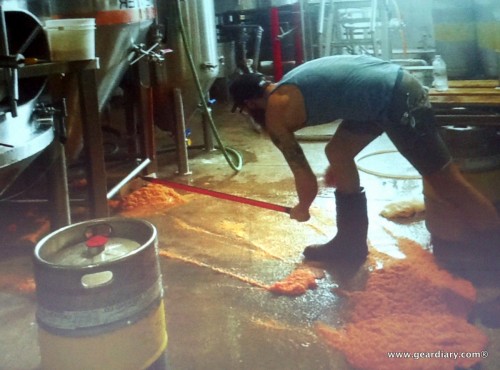 A pic Todd Steven brought of him doing cleanup from?a time when a cantaloupe bag broke open
A pic Todd Steven brought of him doing cleanup from?a time when a cantaloupe bag broke open
Catabwa is going to continue working on all of their flagship beers that are ?really solid, but [they] are having a really great time working on the line of Belgians and sour beers.? This is both Catabwa Valley and Todd Steven?s first Great American Beer Festival, and they are very excited to be here.
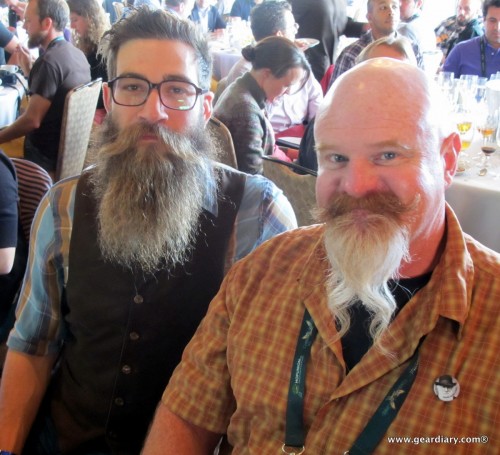 Todd Steven Boera from Catabwa and Kev
Todd Steven Boera from Catabwa and Kev
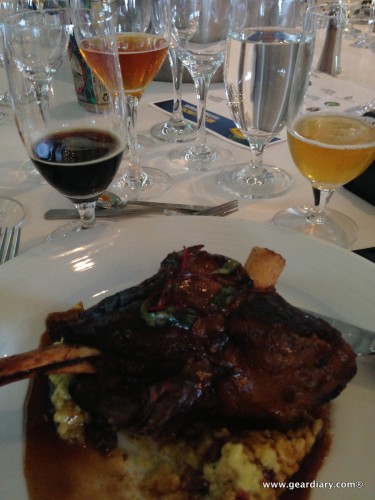
Catabwa Valley Brewing Company?s La Saison Noir is on the left, and Loretta is on the right
Julie came back to introduce Jeff Erway, from?La Cumbre Brewing Company?in?Albuquerque, New Mexico; they won the 2011 gold medal IPA with their Elevated IPA.
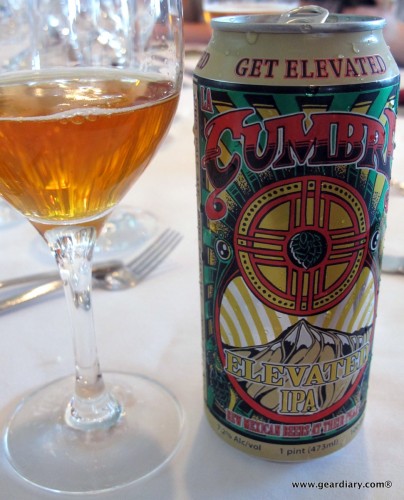
Jeff Erway, is the founder, president and master Brewer at La Cumbre Brewing Company. In 2002 he graduated from college with a Bachelors Degree in Jazz Performance, and he moved to the Navajo Nation with his then friend and now wife Laura, to teach music. In their free time, his wife and he had time to travel all over the country in search of good craft beers; he says that in the course of five years, they visited hundreds of breweries.
In 2003, while passing through Flagstaff, Arizona, they stopped at Homebewers Outpost, a local homebrewing store. Before then, the thought of homebrewing? had never really crossed his mind, but they went in, Jeff met the owner, and after talking with him for 20 minutes, Jeff picked up what has been ?probably the most important book in my life, How to Brew: Everything You Need To Know To Brew Beer Right The First Time, by John Palmer.? He studied that book, and ?probably read it 20 times.?
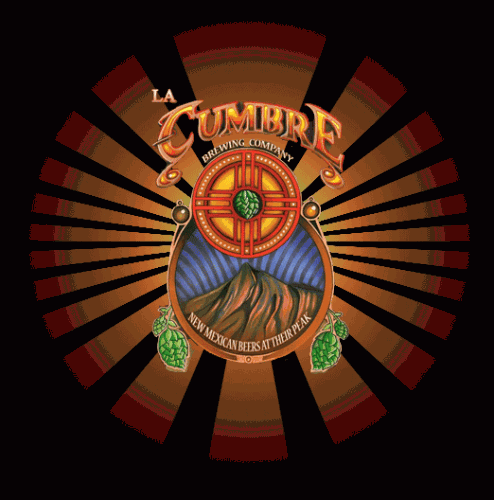
These beers are all we have. They are our pride and joy. No million-dollar ad campaigns. No fancy marketing, just the best beers we can make, served the best way we know how. Come on in to the brewery and try them all. They are all classic interpretations of classic styles, brewed with the finest ingredients available in a time-honored way with a passion that is fueled by our brewer?s absolute and unwavering dedication to the craft.
Over the years, he had the opportunity to hang out with homebrewers who had turned pro,?and he decided that not only did he love their beers, but that they were his kind of people. ?They were humble artists with an honest, blue-collar flair.? It didn?t take him long to realize that ?teaching just wasn?t [his] gig.? So he read and he brewed, and he read and he brewed ?sometimes three batches a week?, and he would stay up late at night ?dreaming of some day when he would be speaking to all of you about what I do and how I got here.?
In 2006, after a number of successes in homebrewing competitions, he was encouraged by a number of local craft brewers to make the leap and get a degree in brewing. In 2007, he enrolled in the American Brewers Guild. He completed that program in June of the same year, and was immediately hired by his ?favorite New Mexico brewery at the time, Chama River Brewing Company.? He eventually made head brewer, and he stayed there until 2009. He left his position on January 1, 2010, and began the task of getting his own brewery up and running.
La Cumbre Brewing Company opened their doors on December 10, 2010, and they have grown to be the 4th largest craft brewing company in New Mexico, as well as the second largest in Albuquerque. What La Cumbre represents to Jeff, ?is a complete lack of compromise; we make beer first and we write budgets later.? In so many ways, he says, their story is ?the story of our industry. We are friendly and forthcoming with our fellow brewers, because that?s how I got into this industry, that?s what attracted me to it.?
Elevated IPA, which won the IPA gold medal at last years GABF and the bronze at this years World Beer Cup, was our last beer with the entree. Jeff said that to make it, they ?use a total of eight hop varieties, and we are adding approximately four pounds of hops per barrel.? Elevated IPA is just over 7% alcohol, and they are just over 100 IBUs (International Bitterness Units). With it, they are ?aiming for a bracing level of bitterness, but not so much as to overpower the malt.? He said, ?for those idealists, and I used to be one of them, shaking their head at their use of hop extract. This typically allows for the use of much more aromatic hops in the boil, without plugging my heat exchanger.? Their beer is FRESH; they are typically tapping a 14-15 barrel batch about every six days.
?Unlike many of the incredibly gifted and creative brewers that you?ll find here this week, I find great freedom in the classic beer styles. I don?t go about reinventing wheels, but what I do is make my beer the best I can, within the style guidelines. When I go out and drink a German-style Pils, I know what I expect, and if I don?t get that, I feel like I?ve been cheated. With Elevated IPA, I am not trying to redefine the style, but simply to make the finest American IPA that I can possibly can.?
Our next speaker,?Charlie Papazian, is a bit of?a living legend; he is the founder and President of the?Brewers Association, the founder of the Great American Beer Festical, and he is the author of The Complete Joy of Homebrewing.

The Brewers Association is an organization of brewers, for brewers and by brewers. More than 1,400 US brewery members and 30,000 members of the American Homebrewers Association are joined by members of the allied trade, beer wholesalers, individuals, other associate members and the Brewers Association staff?to make?up the Brewers Association.
In 1970 Charlie brewed his first batch of beer as a college student at the University of Virginia. ?He was introduced to a neighbor, an ?old-timer who brewed during Prohibition. He asked whether I wanted to taste his homebrew;?I?d never had homebrew, I?d never heard of homebrew,?I didn?t know what it was like. He said, ?Well, if you?re interested, I?ll get the good stuff; I?ll go down to my basement and get the year old stuff.? And this was basically Prohibition style homebrew;?a can of malt extract and eight pounds of sugar, aged for a year in his basement, and it was pretty intriguing. And it had flavor.?
The old-timer gave him the recipe (?five lines on a 3?5 card?), and Charlie and his roommates made their first batches of beer ? and they dumped them down the bathtub. ?They were kind of undrinkable, but we figured out a few things. We found dried brewers yeast instead of bread yeast, and we found corn sugar instead of cane sugar, and we started making stuff that all of our friends really loved, and we loved it, too! And to this day, that spirit of what happened in those first ?homebrewing enjoyment parties? and what is happening at the Great American Beer Festival, and what is happening all over America ? whether it is professionally craftbrewed or homebrew craft brewed ? there is something essential in common with all those experiences. One aspect of it, one of the questions that I asked myself, I think, back in 1970, because I didn?t really enjoy drinking store bought beer ? I just drank it as a college kid, because it was cheap and you could get a little buzz on it ? and I asked myself, WTF? Where?s the FUN? And that?s what it was about. It was fun. But that?s not the message I want you to take away from this. I really think that what?s going on with craft beer and homebreweing is the fun aspect of it, but the interaction is all about captivation. Craft beer is captivating; homebrewing is captivating. Everyone who takes it and experiences it in a group setting, or alone, is captivated by the whole experience and the idea of craft beer. You can?t say that about non-craft beer. And people take it ?in their own directions. The reason that I brew, and I still?brew it these days, I have five homebrews on tap and two fermenters lagering?beer right now, I enjoy it. I don?t brew beer because I have to; I don?t think any professional craft brewer in this room or in America is starting their business, the business of craft brewing, because they had to. It?s because they were captivated by craft beer and the whole ambiance that it creates, and they wanted to do it. There are so many businesses, and so many other things we do because we have to do it; so many things that are made because we have to do it, but you don?t have to make craft beer, you don?t have to start brewing. Everyone who?s in it wants to do it because they have been captivated by it. And that?s the message that I want to give you, that after 40 some odd years, I am till making beer because I am still captivated, and I think all of us are here because we are captivated by the experience that craft beer offers.?
Next was Gary Glass,?the Director, of the?American Homebrewers Association. 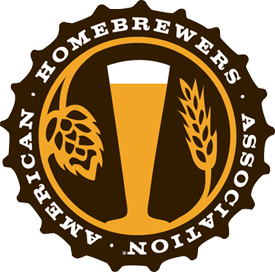
The American Homebrewers Association (AHA) educates?homebrewers, and protects and promotes one of the coolest hobbies in the world?homebrewing!
- Founded 1978 by?homebrew?author and Brewers Association?President?Charlie Papazian in Boulder, Colo.
- More than 30,000 members
Gary wanted to tell us a bit about the state of homebrewing today; they survey their members, they survey retailers, and they have collected stats. ?Right now there are a little over a million people homebrewering in the United States. That?s probably a somewhat conservative estimate, but at least a million people are making beer or wine at home. There are 1327 homebrew clubs in the United States, which is about double what it was 10 years ago, and there are 761 homebrew?retail shops.?
Right now, homebrewing?is experiencing ?the most rapid growth in its history; ?what this is showing is that in the midst of one of the worst economy since the Great Depression, we have this segment of homebrewing that is growing at double-digit growth, and accelerating at double-digit?growth.? As has been mentioned before, there is no shortage of great craft brews available in most stores; people can get just about any kind of beer that they might want from a store. People are getting into homebrewing because they want the experience of brewing for themselves. Bringing homebrew supplies into places like Whole Foods makes the hobby that much more accessible.
The ?go local? movement definitely supports local craft brews, but ?as far as beer goes, it doesn?t get any more local than brewing at home.? There?s also been a demographic shift in the people buying beginner kits; it used to be people who were in their 30s or 40s, people who had bought a house and had a family, that wanted to start a family. Now, almost 50% of the shops out there say that their primary age groups for buying beginner kits are people under 30. With a new age group that is really passionate about homebrewing,?this is a trend that is not going to die out; it is going to accelerate.
?As a homebrewer, you are not beholden to any customers who buy your beer. You can experiment, you can do whatever you want, and if it doesn?t come out great, it?s not a big deal. That is what homebrewing?is all about.?
By now, we were all done with our entree and ready for dessert, apple crepes which had been paired with Flying Fish Brewing Company?s Exit 4 and Maui Brewing Company?s La Perouse White.
First to speak was Casey Hughes, Director of Operations at?Flying Fish Brewing Company, in Cherry Hill, New Jersey. 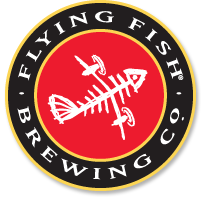 Casey got into the brewing industry in 1995, which was also the same year he graduated high school. He went to college for a ?little bit ? two months ? then went down to Key West on vacation?, and ended up getting a job at a local brewery there. His parents were not thrilled, but they ?are much happier these days than they were back then.? Casey couldn?t legally drink alcohol for the first three years he was at the Key West brewery; he was there for seven years until that brewery closed down, and then he moved to New Jersey.
Casey got into the brewing industry in 1995, which was also the same year he graduated high school. He went to college for a ?little bit ? two months ? then went down to Key West on vacation?, and ended up getting a job at a local brewery there. His parents were not thrilled, but they ?are much happier these days than they were back then.? Casey couldn?t legally drink alcohol for the first three years he was at the Key West brewery; he was there for seven years until that brewery closed down, and then he moved to New Jersey.
He decided to start making some wheat-based beers there, based off the Jersey Turnpike. ?When you think New Jersey, you think ?What exit are you from?? So we decided to make a series of beers based on what the exits are, and to bring some light and fun stuff to New Jersey. ?Our brewery was one of the first breweries to start making Belgian-style beers in the early 1990s; we figured Exit 4 is the exit where we?re at, so we started off with that. We decided to do an American version of a Belgian Trippel. I really like dry Trippels, I don?t like super sweet beers, so I figured what would go great with it but a lot of American Hops in there, so we made this nice 10.5% Trippel, and dry-hopped it like an IPA, pretty much.?
Flying Fish Brewing Company is located in Cherry Hill, New Jersey, approximately seven miles east of Philadelphia. In a state that once boasted 50 breweries, it is the first microbrewery in Southern New Jersey and the first new brewery built in that part of the state in more than half a century. From its opening in late 1996, Flying Fish has tripled its capacity and become the largest of the approximately 20 craft breweries in the state.
Casey was a brewer before he became a homebrewer, and he actually made wine before beer. He loves the Philadelphia area and its huge beer culture, and he enjoys going around and meeting with the clubs and other homebrewers; they all share tips and ideas with each other.
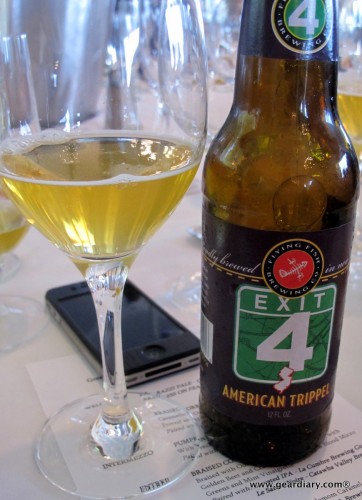
Exit 4?is a nice and dry beer, that has hints of peaches and apple; it worked well with our apple crepes.
Garrett Marrero,?Maui Brewing Company, located in Lahaina, Maui, Hawaii came next, and he jumped right in to tell us about La Perouse White, what they call ?liquid breadfruit?, which is a collaboration beer that they did with ?their good friends Dogfish Head Brewery.? Sam Calagione had come to Maui to visit while on vacation in Hawaii with his little girl, and he asked if he and Garrett could brew together while he was there. Garrett said, ??no problem!? And so it starts off as ?well, maybe we?ll do a homebrew just for fun?, and then it was, ?oh, we?ll do a pub special!?, and then it became a national release, 400 barrels, 3,000 pounds of breadfruit, which is an indigenous species of fruit in the South Pacific, as well as Hawaii, and we decided on toasted papaya seeds used as a spice.?

Maui Brewing?Co.?has?built a reputation for creating?hand-crafted?beers brewed using only the finest natural?ingredients. Founded in 2005 by Garett Marrero and Melanie Oxley, Maui Brewing Co.?is?one of Hawaii?s fastest growing companies and the islands only microbrewery.
La Perouse White is a ?very unique beer; I think that we are doing things that most people don?t think about. And I think that?s where our basis in homebrewing?really is. You know, we really do what Gary [Glass] said, we get to brew what we want to drink, and a lot of these recipes ? a lot of these ideas ? come in that thought process. Well, let?s just try it!? So we did ??
La Perouse White is about?8.2% alcohol by volume; it is an Imperial Golden Ale brewed with breadfruit and toasted papaya seeds. Garrett said that they ?did collect all of the [bread] fruit and all of the toasted papaya seeds by hand; I have never eaten more papaya than I have in my life than I did this summer, so it?s something that we were very committed to.? Maui Brewing Company has become ?somewhat of a serial collaborators?; Garrett says, ?I usually call it a vacation write-off project for those out of state brewers who come to visit us.?
Their next beer will be a Belgian-style Stout brewed with chocolate and chipotle, ?we?re using Big Island chocolate and Hawaiian chili peppers. Again, using local ingredients. In the spring, we are doing a saison, a locally grown lemongrass saison with Tomme Arthur from Lost Abbey Brewery, you may or may not have heard of him, ?fantastic brewer. But like I said, serial collaborators. And I really think that is the essence of what craft beer is all about; its a sense of place, it?s community, it?s the brotherhood of what craft beer is all about.?
?We?re known for a beer called Coconut Porter; when we first started doing Coconut Porter, it was ?what kind of beer? I?don?t know about this?, and now there have been so many evolutions. A good friend of ours from Iron Hill Brewery?was doing a beer last year for a special event, and he asked ?how do you use the coconut?? I just emailed him the recipe, and said ?hey, this is what we?ve done different, and maybe in your style it would work this way?. But, it?s all about an open book, and to share. And if we all believe in sharing, then we all grow together. It?s very different, a paradigm shift in thinking from the large domestic billion-dollar plus American and non-American crowd, domestic lager producers. I think they don?t allow photos in the brewery, Miller doesn?t talk to anybody about, Bud doesn?t talk to anybody, wherever else. You would never see them all in the same room like this, sharing beers and sharing recipes, and we think that what sets us apart from that culture. Community involvement is something that is very important I think to all of us, with breweries like of course, New Belgium, Sierra Nevada, even the local small craft brewery that?s a half-barrel system in the garage. They all are contributing to the community in one way or another, whether that be by job creation, by green efforts and sustainability,?donations, obviously. We do a lot of ?in kind? donations to?non-profits to help them raise money. So, I think this is something important, and it really helps bind the local brewery to its audience, because where you are really defines what your brewery does in a lot of ways, and you can communicate to your audience why you do what you do; you form a relationship, and you pick your product not based on whether it is 50? off today or not, but based on the relationship they have with this company. And I think that this is something that, it goes across all sizes of breweries that are represented here at GABF.?
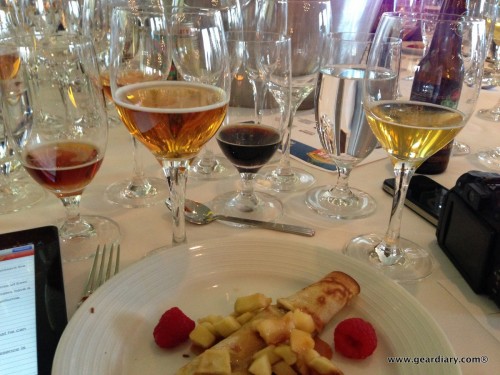
For our cheese course, we opened our last bottle, Blushing Monk, while Dave Engbers of?Founders Brewing Company?in Grand Rapids, Michigan, spoke.
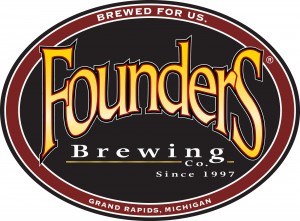
Dave?started by saying, ?I am proud to stand here in front of everyone and say that beer changed my life; craft beer changed my life. Like a lot of adolescents, at the early age of about 15 years old, I started stealing beer off my parents back porch. And I started experimenting a little bit, as kids do. And something huge happened to me when I was 17 years old. I?m the youngest of four children, and at the age of 17, my oldest brother, who had moved out the day he graduated from high school, he?s about 10 years older than myself, so, I really didn?t know him. We had kind of lost contact, he was a hippy, lived in a commune, and all of that kind of stuff, and we kind of reconnected and so my 16th or 17th birthday, I flew out to California and really got to know my oldest brother. He asked me two questions; he said, ?do you smoke? or do you drink??, and as a young kid, I said ?yeah, yeah I smoke. And I drink?, and something huge happened that day, he introduced me to craft beer. Our first stop from the airport was a little store, and we picked up a Mendocino County Red Tail Ale, and it was literally, I?ve got goosebumps right now because it changed my life. I tried a beer that had so much flavor, and it was so different from anything I had ever experienced. That really piqued my interest. And then, growing up I had the opportunity to travel to Europe, and one thing that I saw about beer that I thought was so interesting, was how it works socially. Beer was a huge part of the culture in Europe, and I hadn?t seen that in the United States. I mean, beer was a novelty. And another thing that happened fairly soon afterwards, going to college, and again, being the fourth youngest of four children, my mom was a great cook. She was always in the kitchen, teaching people how to braise, saute, do all these fun things, so food and flavor was always a big part of our family life, and at the age of 19, my parents bought me my first homebrew kit. And I thought, ?I?ve got pretty cool parents!? And it?s kind of funny, because I am looking over here at Charlie [Papazian], and I?m thinking, well, that guy ? we don?t know each other very well, we?ve met maybe a few times ? but you changed my life. If you could only see my book [The Complete Joy of Homebrewing]. If you could only see your?book on my shelf; it is worn, it?s seen better days, it?s spilled, it?s got all these beautiful spills all over it, and I love it. Thank you so much.?
Dave went on to college, where he met his partner, Mike; their pipe dream was to start a brewery. They both worked for beer wholesalers, and they would talk about starting a brewery. Out of college, Dave became an elementary teacher; he did it for a year, but something in the back of his mind was saying, ?you have to do this.? He decided that he wanted to live without regrets, and so he called his partner Mike, and he said ?we are young enough that if this works, it?s great. And if it doesn?t work, we can bounce back and do something else.?
They started Founders Brewing Company in 1997, and the first few years were a struggle. ?I?m not happy to say that we lost money our first ten years, but it is kind of the reality. And we struggled trying to find our voice, and after our first two years, and losing literally hundreds of thousands of dollars the first couple of years, and literally being on the brink of filing for bankruptcy, we said, ?if we are going to go out of business, let?s do it on our own terms. And we said, from now on, we aren?t looking at the popular styles. We?re going to do things our own way, and like so many folks who have been up here today, we brewed beer that we wanted to drink. And that?s now our slogan, ?Brewed for us.? We don?t brew beers for the masses; we?re brewing beers that make us happy. We are very fortunate to be in an industry where the craft beer enthusiasts are extremely engaged in our industry. And with the advent of the internet, we?re extremely accessible. We have folks that call us, and we are very open; we love having brewers come to our brewery. We love opening our doors and showing you what we do. Our entire industry is almost collaborative; we like to help each other out.?
The Founders Family, a group of passionate beer enthusiasts, has grown around this simple philosophy: ?We don?t brew beer for the masses. Instead, our beers are crafted for a chosen few, a small cadre of renegades and rebels who enjoy a beer that pushes the limits of what is commonly accepted as taste. In short, we make beer for people like us.?
In 2007, they moved into their new facility, and that is when their business really took off. They were doing about 5000 barrels a year, but their first year after moving in they doubled their production to around 10,000 barrels a year, the next year was 19,000, the year after that was 28,000, and last year they did 43,000, and this year they are on track to brew 90,000 barrels.
Dave said that their responsibility as brewers ?is to brew the best beer that we can.?
Blushing Monk was presented to us in a champagne glass, and it was an absolutely gorgeous effervescent?raspberry?color and flavor. Dave relayed a conversation he had had with Jason Heystek?(their head cellarman) about how much raspberry they used, and Jason?s reply was, ?oh, about $20,000 worth.?
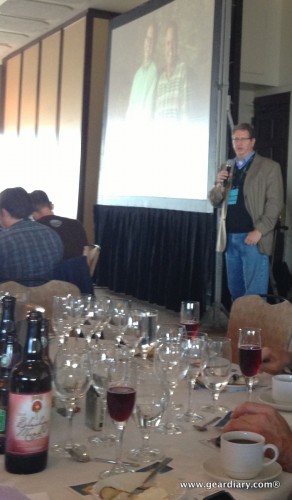 Dave Engbers from Founders Brewery, and our pour of?Blushing Monk
Dave Engbers from Founders Brewery, and our pour of?Blushing Monk
Blushing Monk is a beer that I think I could serve to my friends who don?t really like beer; it was like champagne without the bubbles and without the headache later, and it was perfect with cheese.
After a few closing remarks, our pairing experience was over.
?
And afterward, I was left feeling that I, along with the other 124 members of the media attending the luncheon, had just been privy to something amazing.
To be able to have all of those esteemed brewers in the room, and to hear them talk about their experiences as homebrewers and craftbrewers, was an inspirational treat that I know neither Kevin nor I will soon forget.
legion baby found alive in morgue rockies ashley judd second degree murders bobby petrino brian dunn
No comments:
Post a Comment
Note: Only a member of this blog may post a comment.